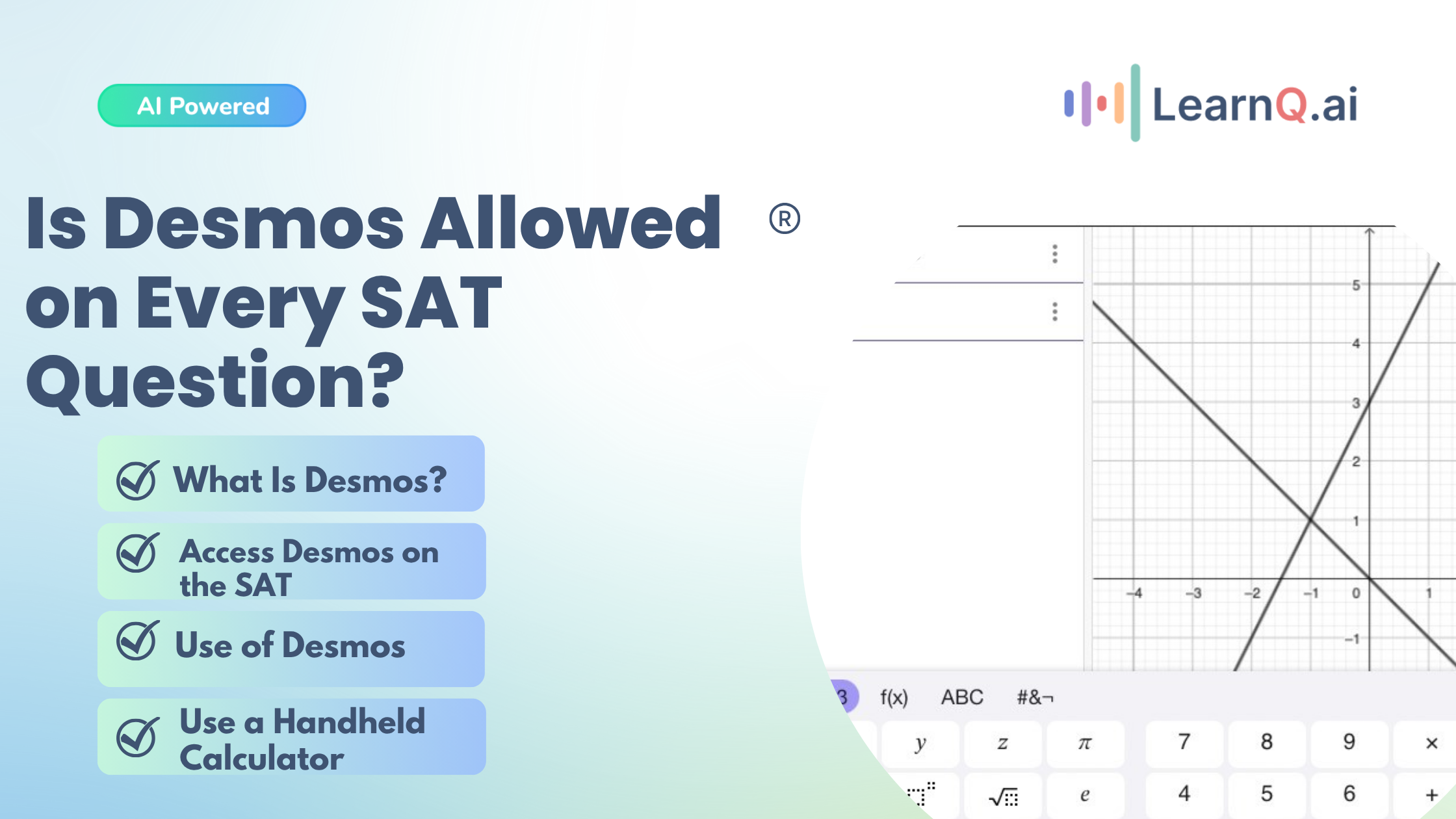Ever feel like the world of standardized tests speaks a different language? You’re not alone. But fear not, intrepid test-taker! This guide will equip you with the knowledge and strategies to confidently navigate the digital SAT Math Test’s geometry section.
Let’s break it down.
Explanation of the digital SAT Math Test structure focusing on Geometry SAT Questions
The digital SAT Math Test throws a diverse range of problems your way, and geometry is no exception. This section typically encompasses around 10% of the questions, testing your ability to understand and apply geometric concepts.
The digital format introduces some interesting twists. Gone are the days of clunky protractors and compasses. Instead, you’ll be presented with interactive visualizations that allow you to rotate 3D shapes and manipulate figures on screen. Pretty cool, right?
But don’t be lulled into a false sense of security by the fancy graphics. A strong grasp of core geometry principles remains essential to conquering these questions.
The significance of mastering geometry for the digital SAT Math Test
So, why spend precious study time wrestling with lines, angles, and circles? Here’s the truth: geometry SAT questions aren’t just about memorizing formulas.
It’s about developing a critical thinking skillset applicable to various areas of the SAT Math Test, not just the dedicated geometry section.
Mastering geometry SAT questions equips you with the ability to:
- Visualize spatial relationships: This skill comes in handy when tackling problems involving distance, area, and volume. Imagine a rectangular prism question – by visualizing the dimensions, you can efficiently calculate its surface area.
- Employ logical reasoning: Geometry problems often involve applying theorems, postulates, and other logical deductions. Acing these questions strengthens your ability to analyze information and arrive at sound conclusions – a valuable skill throughout the entire Math Test.
- Break down complex problems: Many geometry questions involve multiple steps. Understanding geometric concepts allows you to deconstruct the problem, identify relevant formulas, and solve it efficiently.
Think of geometry as your weapon – a powerful tool that unlocks success not just in the dedicated section, but throughout the digital SAT Math Test.
Overview of geometry’s approximation to 10% of the digital SAT math questions
The digital SAT Math Test covers a vast range of mathematical concepts. While the exact proportion might vary slightly from year to year, geometry typically makes up around 10% of the questions you’ll encounter.
While it might seem like a relatively small chunk of the test, don’t underestimate its significance. Mastering geometry SAT questions can give you a strategic advantage. Here’s why:
- Geometry is foundational: A strong understanding of geometric concepts strengthens your ability to solve problems in other areas of the Math Test, like algebra and coordinate geometry.
- Boosts overall score: Performing well in the geometry section can significantly improve your overall Math Test score. Even a few extra correct answers can make a big difference in your percentile ranking.
- Efficient time management: By efficiently solving geometry problems, you’ll free up valuable time to tackle more complex questions in other sections.
Remember, consistent practice is the key. Familiarize yourself with the core concepts outlined in the following section, solve practice problems from various sources, and identify your areas of weakness.
By actively engaging with geometry, you’ll transform this section from a daunting challenge into a strategic opportunity to boost your overall SAT Math Test score.
Key Geometry Concepts for the Digital SAT Math Section
Conquering the digital SAT Math Test is all about mastering the essential skills. And when it comes to geometry SAT questions, a solid understanding of core concepts is your key to success.
Do you want to know more about strategies for SAT Maths sections? Read our blog!
Buckle up, because we’re about to dive into the building blocks you’ll need to ace this section.
Angles: Degrees of Separation
First things first, let’s talk angles. These are formed when two rays (think of them as straight lines extending infinitely in one direction) meet at a common point, called the vertex. The angle’s “spread” is measured in degrees, with a full circle encompassing 360 degrees.
Now, get ready for some vocabulary expansion. You’ll encounter different types of angles:
- Acute angles: These are the shy ones, measuring less than 90 degrees. Imagine a slice of pizza – that sharp corner is an acute angle.
- Right angles: These are the all-stars, measuring exactly 90 degrees and forming a perfect corner, like a square corner.
- Obtuse angles: These are the outgoing ones, spreading out more than 90 degrees but less than 180 degrees. Think of a leaning tower – the angle it makes with the ground is obtuse.
- Straight angles: These go all the way – measuring exactly 180 degrees and forming a straight line. Imagine a flat ruler – that’s a straight angle.
Understanding these angle types and their measurements is crucial for solving problems involving triangles, quadrilaterals, and even circles.
Lines and their Relationships
Lines are like roads that stretch infinitely in one direction. But sometimes, lines have special relationships with each other. Let’s explore two key ones:
- Parallel lines: These are the ultimate BFFs – they travel in the same direction and never, ever intersect no matter how far you extend them. Imagine railroad tracks – those are parallel lines.
- Transversal lines: These are the rebels – they cut across two or more parallel lines, creating special angles at the intersection points. Think of a crosswalk crossing railroad tracks – the crosswalk is the transversal line.
Mastering these line relationships is essential for solving problems involving parallel lines and their properties.
Triangles: A Balancing Act of Sides and Angles
Triangles are the rockstars of geometry SAT questions– three-sided shapes formed by three straight lines meeting at three points (vertices). But triangles aren’t all created equal. Here’s a breakdown of the different types you’ll encounter:
- Equilateral triangles: These are the perfect ones – all three sides and angles are equal. Imagine a honeycomb – those hexagons are made up of equilateral triangles.
- Isosceles triangles: These have two sides that are equal in length. The two angles opposite the equal sides are also congruent (equal in measure). Think of a slice of pie – that’s an isosceles triangle.
- Scalene triangles: These are the rebels of the triangle world – no sides or angles are congruent. They’re the most common type you’ll encounter, so get comfortable with them!
- Right triangles: These have one special angle – a 90-degree right angle. Remember the Pythagorean Theorem? (a² + b² = c²)? That applies to right triangles, where a and b are the lengths of the legs (sides opposite the right angle), and c is the hypotenuse (the longest side).
Understanding triangle properties, including area formulas (remember 12 X base X height?) and the Pythagorean Theorem, is essential for solving a wide range of geometry problems.
LearnQ.ai is Powered by VEGA AI—Is your Institute Next?
Give students a Duolingo-style test-prep platform with Shopify-level customization for tutors and institutes.
Circles: Perfectly Round with Key Measurements
Imagine a perfectly round pizza – that’s a circle! Circles are defined by their key measurements:
- Radius (represented with “r”): This is the distance from the centre point to any point on the circle’s circumference (the outer edge). Think of a slice of pizza – the crust is the circumference, and the distance from the centre to the crust is the radius.
- Diameter (represented with “d/D” ): This is the heavyweight champion – it’s the longest straight line that passes through the centre and cuts exactly across two opposite points on the circumference. It’s two radii put together. Imagine a ruler measuring the diameter of the pizza.
Circles also have interesting features like arcs, which are portions of the circle’s circumference. Understanding these measurements and properties is essential for solving problems involving circles, their areas, and even inscribed shapes within them.
Quadrilaterals: Four-Sided Shapes with Diverse Personalities
Quadrilaterals are the four-sided superheroes of geometry. They come in various shapes and sizes, each with its unique properties. Here’s a quick introduction to some common types:
- Squares: These are the perfectionists – all four sides are equal in length, and all four angles are right angles (90 degrees). Think of a Rubik’s Cube – each side is a perfect square.
- Rectangles: These are the neat freaks with opposite sides that are equal in length and all four angles are right angles. Think of a door – it’s most likely a rectangle.
- Parallelograms: These have parallel sides (like the parallel lines we discussed earlier). Opposite sides are also equal in length, and opposite angles are congruent (equal in measure). Imagine a sheet of notebook paper – that’s a parallelogram.
- Rhombi: These are the flashy ones – all four sides are equal in length, and opposite angles are congruent. Imagine a baseball diamond – the infield is a rhombus.
- Trapezoids: These are the chill ones – they only have one pair of parallel sides. The other two sides can be any length, and the angles can vary. Think of a slice of bread – that’s a trapezoid.
Understanding the properties of different quadrilaterals, including their special angles and side relationships, is crucial for solving problems involving their area and perimeter.
Solids: Unveiling the Mysteries of 3D Shapes
So far, we’ve explored flat shapes. But the digital SAT Math Test might also introduce you to the fascinating world of 3D solids – shapes that have width, height, and depth. Here are some key players:
- Cubes: These are the six-sided superstars – all six sides are squares, and all angles are right angles. Think of a die.
- Cuboids: These are like rectangular boxes – they have six faces, but not all sides are necessarily squares. Opposite sides are congruent, and angles are right angles. Think of a shoebox.
- Spheres: These are the perfect spheres – perfectly round with every point on the surface the same distance from the center. Think of a basketball.
- Cones: Imagine an ice cream cone – that’s a cone! It has a circular base, a curved lateral surface that slopes up to a point (the apex), and a slant height.
- Cylinders: Picture a can of soda – that’s a cylinder! It has two circular bases, a curved lateral surface connecting the bases, and a height that goes straight up between the bases.
- Pyramids: These are like cones with a flat base instead of a circular one. Imagine an Egyptian pyramid – that’s a pyramid!
By mastering these key concepts and practising with various problems, you’ll transform from a geometry novice to a confident conqueror of the digital SAT Math Test.
Geometry SAT questions will no longer be a mysterious landscape, but a well-mapped territory you can navigate with ease and precision. So, equip yourself with this knowledge, diligently practice, and watch your SAT Math Test score soar!
Practice Questions and Answer Techniques: Sharpen Your Geometry Sword
Now that you have understood the core concepts of geometry, it’s time to refine your skills.
Sit tight, because we’re about to get into practice questions and answer techniques and sample questions from the LearnQ.ai practice set that will turn you into a geometry whiz on the digital SAT Math Test.
Angles: Mastering the Art of Degrees
Ready to tackle some angle problems? Here are some key techniques to remember:
- Identify relevant information: Pay close attention to the information provided in the question. Are there parallel lines involved? Is a transversal line creating special angles?
- Apply angle relationships: Remember those angle types from before? Use your knowledge of complementary angles (adding up to 90 degrees), supplementary angles (adding up to 180 degrees), and vertically opposite angles (always congruent) to solve for missing angles.
- Draw diagrams: Don’t underestimate the power of a visual aid. Sketch a diagram to represent the angles and lines mentioned in the question. This can help you visualize the relationships and solve the problem more efficiently.
By mastering these techniques, you’ll conquer any angle-related question the digital SAT throws your way.
Lines: Strategies for Parallel Lines and Beyond
Lines might seem simple, but they can get tricky when it comes to parallel lines and transversals. Here’s how to approach these questions:
- Spot parallel lines: Look for clues that indicate parallel lines, such as double lines or wording like “parallel to.”
- Remember corresponding angles: When a transversal line cuts across parallel lines, it creates corresponding angles (congruent) on opposite sides. Use this knowledge to solve for missing angles.
- Beware of alternate interior angles: These are not your friends! They are located on opposite sides of the transversal line but inside the parallel lines. They are supplementary (add up to 180 degrees) but not congruent. Don’t get confused by them!
Triangles: Masters of Sides and Angles
Triangles are all about their properties – sides, angles, and everyone’s favourite, the Pythagorean Theorem. Here’s how to dominate triangle questions:
- Identify triangle type: Is it an equilateral triangle (all sides equal), isosceles triangle (two equal sides), or a scalene triangle (no equal sides)? Recognizing the type is crucial for using relevant formulas.
- Apply angle relationships: Remember the angle addition property for triangles (all angles add up to 180 degrees)? Use this to solve for missing angles.
- Master the Pythagorean Theorem: This powerhouse formula (a² + b² = c²) applies to right triangles, where a and b are the leg lengths, and c is the hypotenuse (longest side). Memorize it and use it to your advantage!
By utilizing these tips, you’ll be a triangle-taming champion.
Circles: Round and Full of Formulas
Circles might seem simple, but they have their own set of formulas to master. Here’s how to tackle circle questions:
- Recognize key measurements: Remember radius, diameter, and circumference. These are essential for various circle calculations.
- Apply circle formulas: Depending on the question, you might need to use formulas for circumference (2πr), area (πr²), or even arc length and central angle relationships.
- Utilize the digital format: Take advantage of the interactive features! Rotate 3D shapes to visualize circles within them or use measurement tools to calculate distances.
By mastering these techniques, you’ll solve circle problems with precision.
Quadrilaterals: A Family of Four-Sided Shapes
Quadrilaterals come in all shapes and sizes, but some key properties unite them. Here’s how to approach quadrilateral questions:
- Identify the type: Is it a square, rectangle, parallelogram, rhombus, or trapezoid? Different types have different properties.
- Look for parallel sides: Remember those parallel lines we discussed earlier? Parallel sides are a giveaway for parallelograms and rectangles.
- Apply formulas strategically: Depending on the quadrilateral type, you might need to use formulas for area (often involving base and height) or perimeter (adding up all side lengths).
By recognizing these characteristics, you’ll conquer quadrilateral challenges with ease.
Solids: Unveiling the Mysteries of Volume and Surface Area
The digital SAT might introduce you to 3D shapes – solids. Here’s how to solve problems involving their volume and surface area:
- Visualize the solid: Use the interactive features to rotate and examine the 3D shape from all angles. This will help you understand its faces and dimensions.
- Identify relevant formulas: Different solids have different formulas for surface area (total area of all faces) and volume (the 3D space the solid occupies). Memorize or be familiar with formulas for cubes, cuboids, spheres, cones, cylinders, and pyramids.
- Apply formulas accurately: Measure side lengths, heights, and radii (for spheres and cones) using digital tools, and then plug those values into the appropriate formulas to solve for volume or surface area.
By mastering these techniques, you’ll transform from a solid geometry novice to a confident problem-solver.
Remember, consistent practice is key. Look for practice problems from various sources, identify your areas of weakness, and focus on mastering those concepts.
By dedicating time and effort, you’ll transform geometry from a hurdle into a stepping stone to SAT Math Test success!
Geometry Practice Questions Examples: Sharpen Your Skills for the Digital SAT
Feeling prepped with the core concepts of geometry? Now it’s time to practice increasing the depth of your knowledge and also refine your problem-solving approach.
Below is a list of important formulas that you should know well. While some may be provided in the reference sheet, it’s beneficial to learn and understand how to apply them;
Here are explanations for each of the geometry formulas written in the above table:
- Area of a Rectangle: To find the area of a rectangle, you multiply its length by its width. It’s essentially the amount of space inside the rectangle.
- The perimeter of a Rectangle: The perimeter of a rectangle is the total length of its four sides. For a rectangle, you add twice the length and twice the width to get the perimeter.
- Area of a Square: Since all sides of a square are equal, you can find the area by squaring the length of one side. It’s essentially the area of a rectangle where the length and width are the same.
- The perimeter of a Square: The perimeter of a square is the sum of all its sides, which are all equal in length. So, you just multiply the length of one side by 4.
- Area of a Triangle: To find the area of a triangle, you multiply the base of the triangle by its height, and then divide by 2. It’s half the area of a rectangle with the same base and height.
- Area of an Equilateral Triangle: An equilateral triangle has all sides and angles equal. Its area is calculated using a specific formula based on its side length.
- The perimeter of a Triangle: The perimeter of a triangle is the sum of the lengths of its three sides. Each side can have a different length.
- Pythagorean Theorem: In a right triangle, the square of the length of the hypotenuse (the side opposite the right angle) is equal to the sum of the squares of the lengths of the other two sides. This theorem is fundamental in trigonometry and geometry.
- Area of a Circle: The area of a circle is calculated by multiplying the square of the radius by the mathematical constant π (pi).
- Circumference of a Circle: The circumference of a circle is the distance around its edge. It’s calculated by multiplying the diameter of the circle by π, or by multiplying the radius by 2π.
- The volume of a Cube: The volume of a cube is calculated by cubing the length of one of its sides. It’s the amount of space enclosed by the cube.
- Surface Area of a Cube: The surface area of a cube is calculated by summing the areas of all its six faces. Each face is a square, so the area of one face is the square of the side length.
- Volume of a Rectangular Prism: The volume of a rectangular prism is calculated by multiplying its length, width, and height together. It’s the amount of space enclosed by the prism.
- Surface Area of a Rectangular Prism: The surface area of a rectangular prism is the sum of the areas of all its faces. Each face is a rectangle, so you calculate the area of each rectangle and then add them all together.
Enhance your Digital SAT study routine with AI-driven insights and personalized practice tests.
Structured Practice Questions for Each Key Concept
Ready to put your knowledge to the test?
Get yourself a set of practice tests that are designed to solve your questions rather than to confuse you. It should be a replica of the digital SAT exam.
Consider using LearnQ.ai, a platform that offers a complete range of features to help you prepare for the SAT. LearnQ.ai provides a full-length practice test that includes all kinds of geometric shape questions asked in the digital SAT, ensuring comprehensive preparation.
By diligently working through these practice questions, you’ll identify your strengths and weaknesses in each area. Focus on mastering the concepts that challenge you the most.
Below, we have shared a list of questions that are covered in the LearnQ.ai practice tests;
Sample Questions From LearnQ.ai Practice Tests
Special Tips for Approaching Geometry Questions Effectively
Conquering geometry on the digital SAT goes beyond memorizing formulas. Here are some special tips to remember:
- Visualize, visualize, visualize!: Don’t underestimate the power of a visual aid. Sketch diagrams or utilize the interactive features of the digital test to visualize the shapes and relationships mentioned in the problem.
- Read carefully!: Pay close attention to the wording of the question. Identify key details and avoid making careless mistakes due to misinterpretations.
- Plug and chug (strategically): While formulas are important, don’t get stuck blindly substituting numbers. Analyze the problem and identify the formula that applies to the situation at hand.
- Double-check your answers: Before submitting your answer, take a moment to review your calculations and reasoning. Utilize the answer choices to see if your answer makes logical sense in the context of the problem.
By incorporating these tips into your exam strategy, you’ll approach geometry questions with confidence and a clear plan of attack.
Are you searching for digital SAT practice sets? We are here to save you. Read this blog!
Remember, consistent practice is key to success. Utilize this worksheet effectively, seek out additional practice problems, and focus on mastering the concepts that challenge you the most. With dedication and the right approach, you’ll be well on your way to conquering geometry on the digital SAT Math Test!

Understanding the Impact of Digital SAT Math Scores: Geometry’s Role in Your Success
You’ve aced the geometry concepts and honed your problem-solving skills. Now, let’s explore how your digital SAT Math score, heavily influenced by geometry, can impact your college dreams.
The College Admissions Ticket: The Role of Digital SAT Math Scores
The digital SAT Math score plays a crucial role in the Academic Index, a metric many colleges use for admissions decisions. This score reflects your quantitative reasoning skills, a valuable indicator of your potential to succeed in college-level math and science courses.
So, a strong digital SAT Math score can significantly boost your college application. It demonstrates your ability to think critically, analyze problems logically, and apply mathematical concepts – all essential skills for academic success.
Don’t Underestimate Geometry: How It Affects Your Overall Score
Remember how we emphasized the importance of geometry throughout your digital SAT Math prep? Here’s why: geometry often makes up a significant portion (around 10%) of the Math Test. Performing well in this section can significantly improve your overall score.
Think of it like this: excelling in geometry gives you a chance to answer more questions correctly, ultimately leading to a higher overall Math score. This can give you a competitive edge in the college admissions game.
Sharpen Your Geometry Skills, Boost Your Score: Practice Makes Perfect
Now that you understand the importance of geometry in the digital SAT Math Test, let’s talk about how practice questions can elevate your skills and ultimately, your score. Here are some tips:
- Targeted practice: Don’t just solve random problems. Focus on geometry-specific practice questions to solidify your understanding of key concepts and formulas.
- Analyze your mistakes: Don’t just get the answer – understand why it’s correct. Analyze your mistakes on practice problems to identify areas needing improvement.
- Time yourself: The digital SAT is timed, so practising under timed conditions is crucial. Simulate the real test environment to build speed and accuracy.
- Utilize the digital format: Take advantage of the interactive features! Rotate 3D shapes, use measurement tools, and visualize concepts in a way you can’t with traditional paper tests.
By incorporating these tips into your practice routine, you’ll transform from a geometry novice to a confident test-taker. Remember, consistent practice and a strategic approach are the keys to unlocking your full potential on the digital SAT Math Test.
LearnQ.ai is powered by VEGA AI—Is your institute next?
Offer students a Duolingo-style test-prep platform with Shopify-level customization for tutors and institutes.






Conclusion
Mastering geometry concepts is crucial for success in the SAT Math section. Practising geometry SAT questions can be an invaluable tool in your preparation, helping you familiarize yourself with the types of questions you’ll encounter and sharpen your problem-solving skills.
By consistently practising with these practice tests, you can build confidence in your abilities and improve your performance on the SAT.
To further enhance your preparation, consider using Learnq.ai, a comprehensive platform designed specifically for SAT preparation. LearnQ.ai offers a complete range of features to help you excel in the SAT Math section, including full-length practice tests that include geometry questions similar to those on the actual exam.
With LearnQ.ai, you can track your progress, and focus your study efforts where they’re needed most. Incorporating LearnQ.ai into your study routine can be a game-changer, providing you with the tools and resources you need to ace the SAT Math section.











